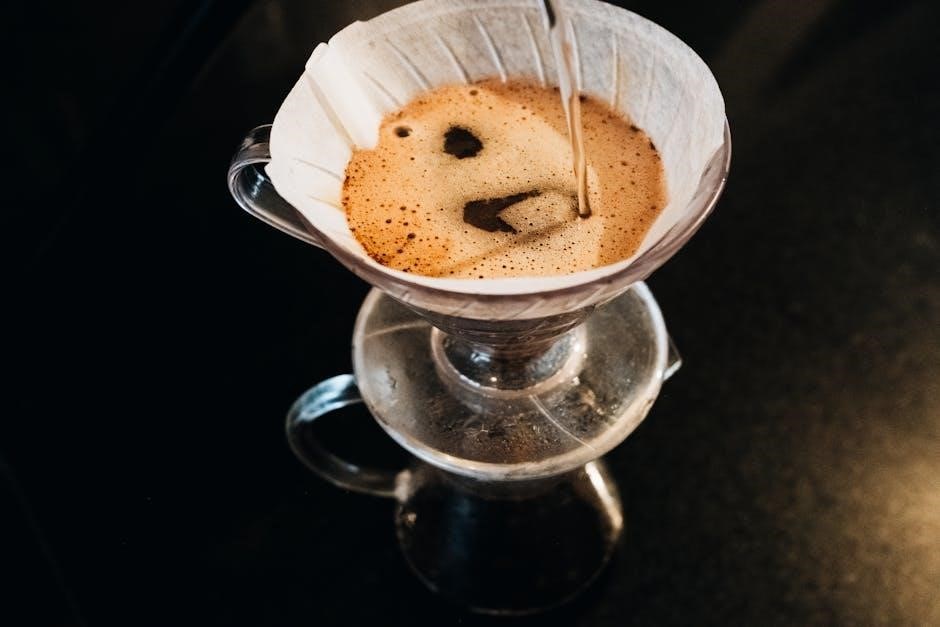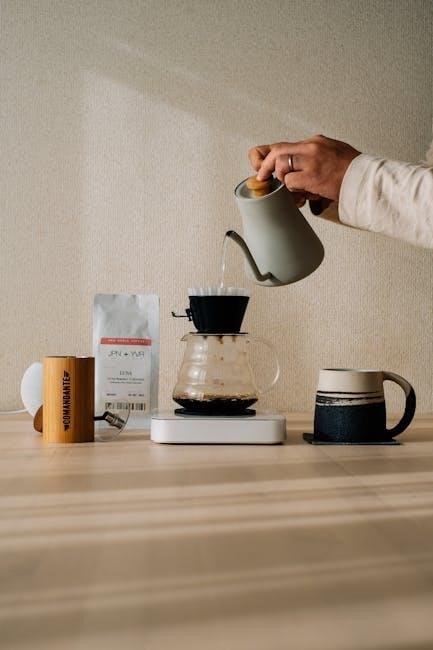Welcome to the Midea Hot Water System Manual, your comprehensive guide to understanding and optimizing your water heater. This manual covers installation, operation, maintenance, and safety tips to ensure efficient and safe use of your system.
1.1 Overview of the Midea Hot Water System
The Midea Hot Water System is a household appliance designed to provide efficient and reliable hot water supply. It is suitable for indoor installation in areas where hot water is needed. The system operates without a plug, requiring direct connection to a power source. Key features include high and low pressure protection and stable hot water production during defrosting. A tempering valve must be connected to the hot water outlet, installed by an authorized plumber. The system can reach temperatures up to 75°C, necessitating careful adjustment to prevent scalding. This overview highlights its core functionality and essential components for safe operation.
1.2 Importance of Reading the Manual
Reading the Midea Hot Water System Manual is crucial for safe and efficient operation. It provides essential guidelines to prevent accidents, such as scalding from hot water, and ensures proper installation. The manual outlines critical safety precautions, including warnings about high temperatures and electrical connections. By following the instructions, users can avoid potential hazards and maintain the system’s performance. Proper installation, as detailed in the manual, is vital to prevent issues like water leaks or system damage. This guide also serves as a handy reference for troubleshooting and maintaining the system. Always keep the manual for future consultations to ensure optimal functionality and safety.
Installation Requirements
Ensure proper installation by following guidelines for space, plumbing, and electrical connections. Connect to potable water supply and install indoors where hot water is needed. Use appropriate wiring and insulation for safety and efficiency.

2.1 Space and Location Considerations
When installing the Midea Hot Water System, ensure adequate space for proper ventilation and maintenance. Locate the unit indoors in an area where hot water is needed, avoiding direct sunlight and moisture. Keep it away from flammable materials and ensure easy access for future servicing. Proper placement prevents damage and ensures optimal performance. Always follow local plumbing codes and manufacturer recommendations for installation sites. Correct positioning is crucial for safety, efficiency, and longevity of the system.
2.2 Plumbing and Electrical Connections
Ensure all plumbing connections are secure and compatible with the Midea Hot Water System. Connect the inlet and outlet pipes according to the manual, using appropriate materials to prevent leaks. Install a one-way valve on the water inlet to avoid backflow. For electrical connections, wire the system to a 220-240 VAC supply, adhering to local codes and ensuring all connections are tightly secured. Proper insulation of hot water lines is essential to conserve energy and prevent heat loss. Always consult a licensed professional if unsure about any step to guarantee safety and compliance with regulations.

Operating the Midea Hot Water System
Learn how to adjust temperature settings, utilize energy-saving modes, and monitor system performance for optimal efficiency and safety. Understand automatic functions and manual overrides for tailored use.
3.1 Understanding Temperature Settings
The Midea Hot Water System allows you to set your preferred temperature between 40°C to 75°C for optimal comfort and energy efficiency. The system automatically turns off when the set temperature is reached, ensuring safety and preventing overheating. Adjusting the temperature is straightforward using the control panel, where you can select from preset modes or customize settings. It’s important to test the water temperature before use to avoid scalding. The outlet temperature should be adjusted based on your household needs, with a recommended setting of 55°C to 60°C for most applications. Always refer to the manual for precise guidance.
3.2 Energy-Saving Features and Modes
The Midea Hot Water System is designed with advanced energy-saving features to minimize energy consumption while maintaining optimal performance. The ECO mode reduces energy use by automatically adjusting water temperature based on demand, while Smart mode learns your usage patterns to optimize heating schedules. Additionally, the system incorporates a heat pump technology that extracts heat from the environment, providing up to 3:1 energy efficiency compared to traditional electric water heaters. These features not only lower your energy bills but also reduce environmental impact. The refrigerant E-heater design ensures stable hot water production during defrosting, further enhancing efficiency and reliability.
Maintenance and Care
Regular maintenance ensures optimal performance and longevity of your Midea Hot Water System. Schedule periodic inspections, clean filters, and replace worn-out parts to prevent issues and ensure efficiency.
4.1 Regular Checks and Inspections
Regular checks and inspections are crucial to ensure the Midea Hot Water System operates efficiently and safely. Inspect the system for leaks, corrosion, or damage. Check the temperature settings to ensure they align with your needs. Verify the pressure relief valve is functioning correctly and replace it if necessary; Examine the electrical connections for any signs of wear or damage. Ensure proper insulation of hot water lines to minimize heat loss. Regularly test the water temperature to prevent scalding. Schedule professional inspections annually to identify and address potential issues early. These checks help maintain performance, safety, and longevity of the system.
4.2 Cleaning and Replacing Parts
Regular cleaning and replacing of parts ensures optimal performance and longevity of the Midea Hot Water System. Scale buildup in the heater can reduce efficiency, so periodic descaling is recommended. Inspect and clean the filter to ensure proper water flow. Replace worn-out seals or gaskets to prevent leaks. Check the anode rod and replace it if corroded to prevent tank damage. Refer to the manual for specific replacement procedures. Always turn off power and water supply before performing maintenance. If unsure, consult a professional for complex replacements. Regular part maintenance ensures reliable hot water supply and prevents costly repairs. Schedule checks annually for best results.

Safety Precautions
Always follow safety guidelines to avoid accidents. Ensure proper installation and regular checks. Keep children away from hot water outlets. Avoid exposure to high temperatures initially. Adhere to manual instructions for electrical and gas safety.
5.1 Warnings to Prevent Scalding
The Midea Hot Water System can produce water at extremely high temperatures, up to 75°C, posing a risk of scalding. Always test water temperature before use. A tempering valve is recommended to regulate water temperature and prevent burns. Ensure the valve is installed by a licensed plumber. Keep children and vulnerable individuals away from hot water outlets. Never expose bare skin to water immediately after heating. Allow water to mix with cold water before use. Regularly inspect temperature settings and adjust as needed to avoid excessive heat. Follow all safety guidelines provided in this manual to minimize scalding risks.

5.2 Electrical and Gas Safety Guidelines
Ensure the Midea Hot Water System is installed by a qualified technician to comply with local safety standards. Always disconnect the power supply before performing maintenance. For gas models, check for leaks and ensure proper ventilation to prevent carbon monoxide buildup. Never use damaged or frayed electrical cords. Keep the system away from flammable materials. Regularly inspect gas lines and electrical connections for wear. In case of a gas leak, turn off the supply immediately and ventilate the area. Follow all safety instructions provided in the manual to prevent electrical or gas-related hazards and ensure safe operation of your hot water system.

Troubleshooting Common Issues
Identify and resolve common issues like no hot water, low pressure, or leaks by checking power supply, gas lines, and pressure valves. Consult the manual for detailed solutions or contact Midea support for professional assistance.
6.1 No Hot Water or Low Pressure
If your Midea hot water system isn’t producing hot water or has low pressure, check the power supply, gas lines, and water inlet connections. Ensure the system is turned on and the temperature settings are correct. Verify that the circuit breaker or fuse hasn’t tripped. If using gas, confirm that the supply is open. Inspect the pressure valve for any blockages or malfunctions. Refer to the manual for specific troubleshooting steps or contact Midea support for professional assistance. Regular maintenance can help prevent such issues and ensure optimal performance.
6.2 Leaks or Strange Noises
If you notice leaks or unusual noises from your Midea hot water system, inspect the connections and valves for tightness. Leaks may stem from loose fittings or worn-out seals. Strange noises, such as clanking or gurgling sounds, could indicate debris in the system or issues with the heating element. Check the pressure relief valve for proper function and ensure the water inlet filters are clean. Avoid using harsh chemicals for cleaning, as they may damage components. Refer to the manual for guidance on addressing these issues. If problems persist, contact Midea customer support for professional assistance to prevent further damage.
By following this manual, you can ensure optimal performance, safety, and energy efficiency from your Midea Hot Water System. Proper maintenance and adherence to guidelines will extend its lifespan and provide reliable hot water supply for years to come.
7.1 Final Tips for Optimal Performance
Regularly inspect and maintain your Midea Hot Water System to ensure peak performance. Adjust temperature settings to balance comfort and energy efficiency. Utilize energy-saving modes to reduce consumption. Ensure all pipes are well-insulated to minimize heat loss. Always follow the recommended maintenance schedule and address any issues promptly. Keep the surrounding area clean and well-ventilated. Schedule annual professional check-ups to maintain efficiency and safety. Monitor your water usage patterns to optimize settings. By following these tips, you can enjoy consistent hot water supply while maximizing energy savings and extending the lifespan of your system.
7.2 Contact Information for Support
For any inquiries or assistance regarding your Midea Hot Water System, please contact our dedicated customer service team. You can reach us at 1-800-MIDEA-CARE (1-800-643-2273) or via email at support@midea.com. Visit our official website at www.midea.com for more resources, troubleshooting guides, and downloadable manuals. Our support team is available 24/7 to address your concerns. For regional-specific support, refer to the contact details provided in your manual or on the Midea website. Ensure to have your product model number ready for faster assistance. Your satisfaction is our priority!
